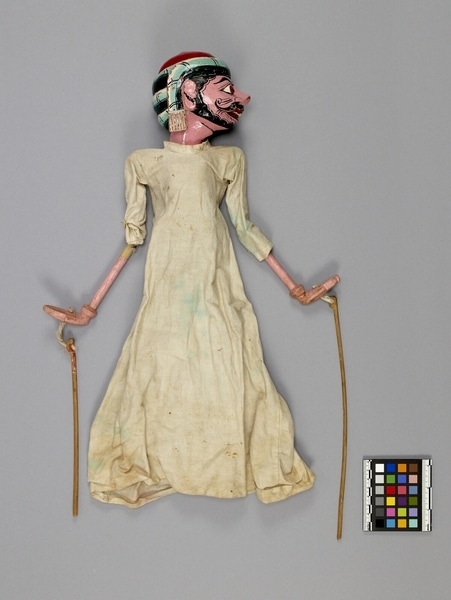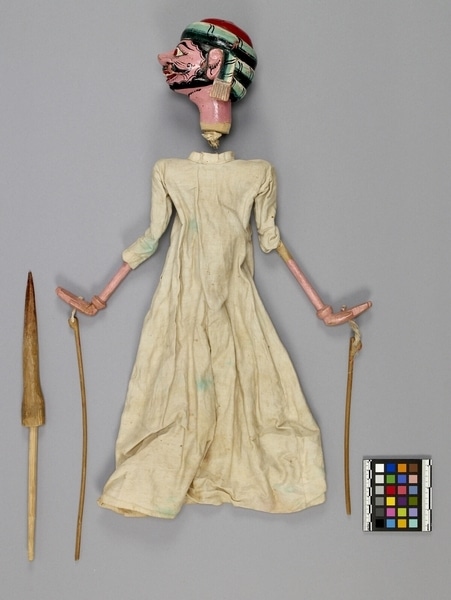Rod Puppet Item Number: Ib285 a-c from the MOA: University of British Columbia


Description
Three-dimensional male puppet: large head (part b) fits into body with tunic (part a), and a control rod (part c) with a long shaft passes through the body and fits into the neck of the figure's head. The body has jointed arms, each with a long controlling rod attached. Figure has a pink face with red irises, and lips. Hair, moustache, beard and facial detail in black. Triangular, upturned nose, and small white upper teeth. Red cap with carved representation of wound cloth in three coils of white, light and dark green, with vertical black stripes. Hanging ends of coil behind each ear. Wide shoulders, slim torso, very long pink arms with pink ornaments at wrists. Fingers held flat, hand bent back at wrist. Body clothed in single beige garment with wide yoke collar.
History Of Use
Javanese puppetry as an art form probably developed by the 11th century. Wayang golek puppets of western Java appeared during the 16th century. Originally the plays depicted Javanese mythology, but after the Indian conquest of Java the Hindu epics, Ramayana and Mahabharata, were incorporated into the cycles, which comprise about 200 plays. A dalang (puppet master) performs the plays to celebrate important occasions, usually in three acts, with vocal and instrumental accompaniment. Typically they serve a moral and religious purpose, and more recently, one of political commentary. Betara Narada is found in all golek cycles, usually appearing in the role of messenger of the gods, or as an advisor to one of the conflicting sides.
Cultural Context
Theatrical performance.
Iconographic Meaning
Each puppet is characterized by it's wanda, a Javanese word which describes the specific mixture of elements of size, form, colour, ornamentation and carving. Skin colour, red irises indicate aggressiveness or determination. Position of head and upward looking eyes considered irreverent. Exaggerated facial features, extensive facial hair are not refined. Wound headdress, facial features, clothing and the position of each hand identifies this puppet as Narada, a god (betara).
Item History
- Made in Java, Indonesia
- Owned by Tradewind Antiques before March 15, 1983
- Received from Museum of Anthropology Shop Volunteers (Funding source) and Tradewind Antiques (Seller) on March 15, 1983
What
- Name
- Rod Puppet
- Identification Number
- Ib285 a-c
- Type of Item
- puppet
- Material
- wood, fibre, paint and cotton fibre
- Manufacturing Technique
- carved, woven, sewn, tied and painted
- Part A
- height 49.5 cm, width 13.0 cm, depth 7.0 cm
- Part B
- height 12.5 cm, width 8.5 cm, depth 11.0 cm
- Part C
- height 33.1 cm, width 2.7 cm, depth 1.7 cm
Who
- Culture
- Sundanese
- Previous Owner
- Tradewind Antiques
- Received from
- Museum of Anthropology Shop Volunteers (Funding source) and Tradewind Antiques (Seller)
Where
- Holding Institution
- MOA: University of British Columbia
- Made in
- Java, Indonesia
When
- Ownership Date
- before March 15, 1983
- Acquisition Date
- on March 15, 1983
Other
- Condition
- fair
- Accession Number
- 0886/0019 a-c